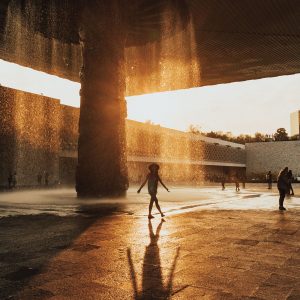My husband and I were recently at dinner with a couple we hadn’t seen in nearly 10 years. We played catch up roulette. You know, the usual questions. Do you plan to have another kid? What do you do for a living now? How was year one of marriage compared to year five?
As I struggled to summarize the last decade of my life — not an easy task, as I sometimes have a hard time recalling what happened last week—I casually said, “I’m actually visually impaired now. Well, I always have been, just didn’t know it. But I’m losing my vision. Going blind. Pass the butter, please.”
I have a rare degenerative eye condition called retinitis pigmentosa. There is currently no known treatment or cure, and it gets worse over time. I see in tunnel vision, and each year, I see a little less.
The retina is the outermost layer of the eye. It’s responsible for converting light into electrical impulses that travel along the optic nerve to the brain, translating into what we call sight. My retinas are slowly dying. They’re programmed by a mutation in my DNA to disintegrate from the outside in.
In 2010, after months of testing, I was diagnosed and immediately made the decision to stop driving. 2010 was also the year Instagram made its debut. Without my driver’s license, my world came to a screeching halt. I walked everywhere and noticed new details on my commute: weeds shooting out of cracks in the sidewalk, wiggly worms, dancing light. I became observant, and I became a better artist for it, capturing my observations with my iPhone and sharing them on Instagram.
The social media platform became my community and outlet—a safe place to share my stories and photos and even to connect virtually with other visually impaired individuals. I became one of Instagram’s first “Suggested Users” and, subsequently, an influencer before it was even a thing. Fast-forward eight years, and it turns out noticing and appreciating weeds in cracks—focusing on what I can see and do rather than what I can’t—radically transformed my life.
Fortunately, technological advancements in the field of retinal research are progressing by leaps and bounds. My ophthalmologist, Dr. Jacque Duncan at the University of California, San Francisco, works closely with the Foundation Fighting Blindness on research studies and clinical trials. While eventual blindness seemed inevitable at the time of my diagnosis, it is now unlikely I will surrender my vision entirely. A prosthetic retina recently became FDA-approved, and stem cell research and genetic treatments show promise. There is a lot of hope.
I’ve been in a perpetual in-between stage since the day an optometrist told me I had the worst peripheral vision of anyone she’d encountered in a routine eye exam. Not blind, but not normal vision either. Not able to drive, but able to see well enough to bike, backpack, snowboard, summit mountains, travel the world, skydive and “influence” people to live more adventurously.
I could write a book—well, actually, I did—about all the things this diagnosis has taught me, but the biggest thing undoubtedly is gratitude. I am so grateful to live in a time where a scary eye condition isn’t a ticket to darkness, where people with disabilities like mine are able to thrive and even see stronger representation in the media. Making it a point to appreciate everything I’m able to see while I can still see it has radically impacted my approach to life itself. It’s not the story I would have written, but I’ll be damned if it slows me down.
This story first appeared in RANGE Magazine Issue 10, which is dedicated to the idea of progress. Get your hands on a copy HERE.
XX Laura Lawson Visconti




